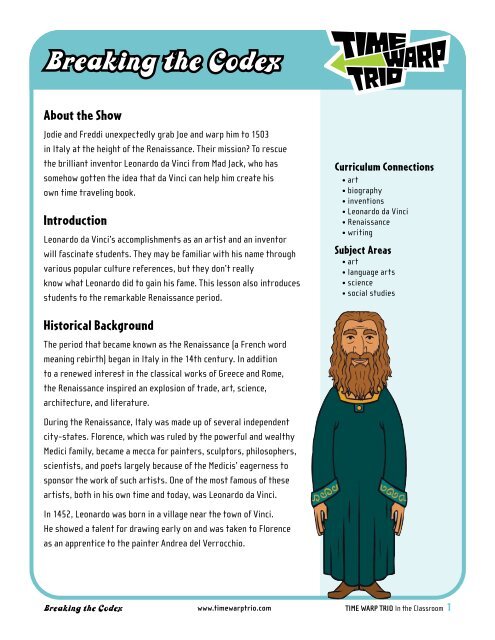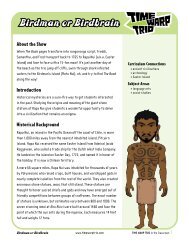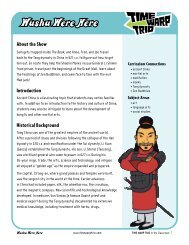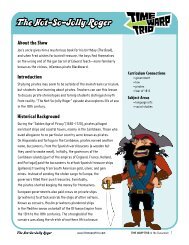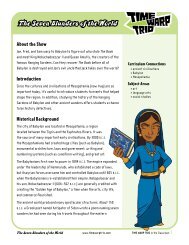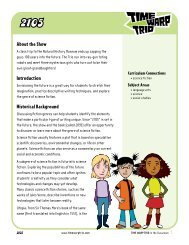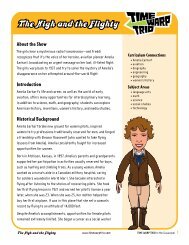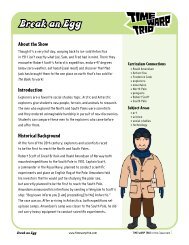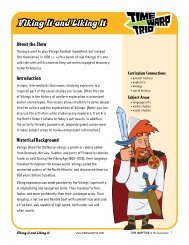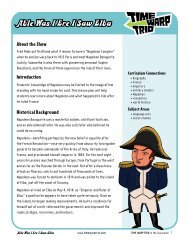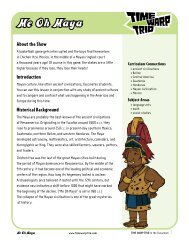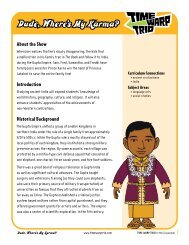Breaking the Codex - Time Warp Trio
Breaking the Codex - Time Warp Trio
Breaking the Codex - Time Warp Trio
Create successful ePaper yourself
Turn your PDF publications into a flip-book with our unique Google optimized e-Paper software.
<strong>Breaking</strong> <strong>the</strong> <strong>Codex</strong><br />
About <strong>the</strong> Show<br />
Jodie and Freddi unexpectedly grab Joe and warp him to 1503<br />
in Italy at <strong>the</strong> height of <strong>the</strong> Renaissance. Their mission? To rescue<br />
<strong>the</strong> brilliant inventor Leonardo da Vinci from Mad Jack, who has<br />
somehow gotten <strong>the</strong> idea that da Vinci can help him create his<br />
own time traveling book.<br />
Introduction<br />
Leonardo da Vinci’s accomplishments as an artist and an inventor<br />
will fascinate students. They may be familiar with his name through<br />
various popular culture references, but <strong>the</strong>y don’t really<br />
know what Leonardo did to gain his fame. This lesson also introduces<br />
students to <strong>the</strong> remarkable Renaissance period.<br />
Historical Background<br />
The period that became known as <strong>the</strong> Renaissance (a French word<br />
meaning rebirth) began in Italy in <strong>the</strong> 14th century. In addition<br />
to a renewed interest in <strong>the</strong> classical works of Greece and Rome,<br />
<strong>the</strong> Renaissance inspired an explosion of trade, art, science,<br />
architecture, and literature.<br />
During <strong>the</strong> Renaissance, Italy was made up of several independent<br />
city-states. Florence, which was ruled by <strong>the</strong> powerful and wealthy<br />
Medici family, became a mecca for painters, sculptors, philosophers,<br />
scientists, and poets largely because of <strong>the</strong> Medicis’ eagerness to<br />
sponsor <strong>the</strong> work of such artists. One of <strong>the</strong> most famous of <strong>the</strong>se<br />
artists, both in his own time and today, was Leonardo da Vinci.<br />
In 1452, Leonardo was born in a village near <strong>the</strong> town of Vinci.<br />
He showed a talent for drawing early on and was taken to Florence<br />
as an apprentice to <strong>the</strong> painter Andrea del Verrocchio.<br />
<strong>Breaking</strong> <strong>the</strong> <strong>Codex</strong><br />
www.timewarptrio.com<br />
Curriculum Connections<br />
• art<br />
• biography<br />
• inventions<br />
• Leonardo da Vinci<br />
• Renaissance<br />
• writing<br />
Subject Areas<br />
• art<br />
• language arts<br />
• science<br />
• social studies<br />
<strong>Time</strong> <strong>Warp</strong> <strong>Trio</strong> In <strong>the</strong> Classroom
<strong>Breaking</strong> <strong>the</strong> <strong>Codex</strong><br />
Historical Background continued<br />
Although only a few of his paintings survive—<strong>the</strong> most famous of which is <strong>the</strong> Mona Lisa—Leonardo’s<br />
superb use of color, perspective, and line make each of <strong>the</strong>m a masterpiece.<br />
In addition to being a master painter, Leonardo was an extraordinarily brilliant sculptor, thinker,<br />
architect, scientist, and inventor, as well as a musician and an engineer. Among <strong>the</strong> many inventions he<br />
created or envisioned—hundreds of years ahead of his time—were <strong>the</strong> submarine, tank, helicopter,<br />
bicycle, and telescope. Many of Leonardo’s creations were never finished, but he left behind thousands<br />
of pages of drawings, records, experiments, observations, and plans in dozens of notebooks.<br />
Unfortunately, many more pages were lost. They were each in Leonardo’s distinctive script, written<br />
from right to left and requiring a mirror to read <strong>the</strong>m. It is not known why Leonardo wrote this way,<br />
but some <strong>the</strong>orize that he used backward writing to keep his ideas secret.<br />
Although Leonardo experienced great success throughout his life, he was constantly in search of<br />
a patron. One of <strong>the</strong> most unlikely of his patrons was Cesare Borgia, <strong>the</strong> son of <strong>the</strong> corrupt Pope Alexander<br />
II. A brilliant but ruthless general, Borgia’s goal was to seize control of central Italy from <strong>the</strong> French<br />
who <strong>the</strong>n ruled it. Leonardo traveled with Borgia for a year as a military engineer, inspecting fortresses<br />
and making maps.<br />
Around 1516, Leonardo left Italy for France, where he lived out his final days in <strong>the</strong> court of Francis I.<br />
He took with him his notebooks and three paintings, including <strong>the</strong> Mona Lisa. In 1860, historian Jacob<br />
Burckhardt referred to Leonardo as <strong>the</strong> “universal man,” because he had excelled in so many areas.<br />
Today we often refer to such a genius as a “Renaissance man” or a “Renaissance woman.”<br />
<strong>Breaking</strong> <strong>the</strong> <strong>Codex</strong><br />
Want students to get even more<br />
excited about history?<br />
Check out <strong>the</strong> Leonardo adventure for kids at<br />
www.timewarptrio.com/adventures/leonardo/<br />
www.timewarptrio.com<br />
Put It Back, Jack! and o<strong>the</strong>r interactive games to play.<br />
Plentifax 487—<strong>the</strong> ultimate time traveler’s guide—gives facts about<br />
Leonardo, <strong>the</strong> Renaissance, Italy, and more!<br />
Cool Books that kids will love.<br />
<strong>Time</strong> <strong>Warp</strong> <strong>Trio</strong> In <strong>the</strong> Classroom
Activity<br />
The Da Vinci “Code”<br />
as Freddi, Jodie, Fred, and Joe discover in “<strong>Breaking</strong> <strong>the</strong><br />
<strong>Codex</strong>,” Leonardo kept copious notes of his inventions,<br />
ideas, and visions written in handwriting that could only<br />
be read by reflecting it in a mirror. in this activity, students<br />
will enjoy copying Leonardo’s special writing technique.<br />
Instructions<br />
. Explain to students that <strong>the</strong>y will try writing as Leonardo da<br />
Vinci did in his notebooks. It is a mystery why he did it, but he used<br />
“mirror writing” (writing backwards and across <strong>the</strong> page from<br />
right to left) and wrote with his left hand. The best way to read<br />
this type of writing is by holding a mirror up to it so <strong>the</strong> reflection<br />
allows you to see <strong>the</strong> words correctly. Ask students to try writing<br />
<strong>the</strong>ir letters backwards, from right to left, using <strong>the</strong>ir left hands.<br />
. Have <strong>the</strong>m try writing <strong>the</strong> alphabet forward and backward.<br />
1<br />
. Distribute mirrors or arrange a mirror station. Have students hold<br />
up <strong>the</strong>ir backward writing and see if it looks normal.<br />
4. Ask volunteers to write a backward message to a classmate and see<br />
if he or she can read it with a mirror.<br />
5. Discuss o<strong>the</strong>r writing systems that are not written and/or read<br />
left to right. For instance, in Hebrew words and sentences are read<br />
from right to left. Chinese writing is read from top to bottom<br />
starting at <strong>the</strong> right hand side of <strong>the</strong> page.<br />
<strong>Breaking</strong> <strong>the</strong> <strong>Codex</strong> www.timewarptrio.com<br />
Objective<br />
• to experiment with writing<br />
and writing systems<br />
Materials<br />
• writing supplies<br />
• mirrors<br />
Curriculum Standards<br />
• NCSS<br />
Culture: The students will be<br />
able to describe ways in which<br />
language, stories, folktales,<br />
music and artistic creations<br />
serve as expressions of culture<br />
and influence behavior of people<br />
living in a particular culture.<br />
• NCTe/ira<br />
The students will develop an<br />
understanding of and respect<br />
for diversity in language use,<br />
patterns, and dialects<br />
across cultures, ethnic groups,<br />
geographic regions, and<br />
social roles.<br />
<strong>Time</strong> <strong>Warp</strong> <strong>Trio</strong> In <strong>the</strong> Classroom
Activity<br />
See It Now!<br />
2<br />
in this activity, students create an advertisement in honor<br />
of one of Leonardo da Vinci’s inventions or innovations.<br />
Instructions<br />
. Have students research Leonardo da Vinci’s many inventions and<br />
innovations. Create a list on <strong>the</strong> board.<br />
. Discuss <strong>the</strong> elements of a good billboard or advertisement: image, title,<br />
tagline, etc. If possible, bring in some samples to share with students.<br />
. Working in teams, have students create an ad featuring one of Leonardo’s<br />
inventions from <strong>the</strong> classroom list. They will need to decide <strong>the</strong> most<br />
important feature or function of <strong>the</strong> invention and <strong>the</strong>n figure out how<br />
to show it in <strong>the</strong> advertisement.<br />
4. Have each team present <strong>the</strong>ir ad or billboard to <strong>the</strong> class. Discuss why<br />
<strong>the</strong>y selected <strong>the</strong> invention and <strong>the</strong> process <strong>the</strong>y went through to develop<br />
<strong>the</strong> ad. Display <strong>the</strong> ads in <strong>the</strong> classroom.<br />
Take It Fur<strong>the</strong>r<br />
Leonardo da Vinci was called a “Renaissance man” because he was talented<br />
in so many different areas. Discuss with students what <strong>the</strong> term means<br />
and <strong>the</strong>n have students nominate <strong>the</strong>ir choice for “Renaissance man/woman”<br />
of today.<br />
<strong>Breaking</strong> <strong>the</strong> <strong>Codex</strong> www.timewarptrio.com<br />
Objectives<br />
• to become familiar with Leonardo<br />
da Vinci and his inventions<br />
• to create an advertisement or<br />
billboard<br />
• to become more media literate<br />
Materials<br />
• large tag board, at least 24" x 36"<br />
• art and writing supplies<br />
Curriculum Standards<br />
• NCSS<br />
Science, Technology, & Society:<br />
Students will identify and<br />
describe examples in which<br />
science and technology have<br />
changed <strong>the</strong> lives of people.<br />
• NCTe/ira<br />
Students use a variety of<br />
technological and information<br />
resources to ga<strong>the</strong>r and<br />
syn<strong>the</strong>size information and<br />
to create and communicate<br />
knowledge.<br />
<strong>Time</strong> <strong>Warp</strong> <strong>Trio</strong> In <strong>the</strong> Classroom 4
Resources<br />
Recommended Books<br />
For Teachers<br />
Florence: The Golden age<br />
1138–1737 by Gene Adam Brucker.<br />
(University of California Press, 1998)<br />
A chronicle of <strong>the</strong> social, economic,<br />
religious, and cultural factors that<br />
led to Florence’s preeminence during<br />
<strong>the</strong> Renaissance.<br />
The Greenwood encyclopedia of<br />
Daily Life, Volume 3 edited by Joyce<br />
E. Salisbury. (Greenwood Press, 2004)<br />
A comprehensive look at <strong>the</strong> lives<br />
of ordinary people in <strong>the</strong> 15th and<br />
16th centuries—<strong>the</strong>ir clo<strong>the</strong>s, food,<br />
culture, customs, beliefs, etc.<br />
inventing Leonardo by Richard<br />
A. Turner. (University of California<br />
Press, 1994)<br />
A study of Leonardo’s life and works<br />
and an analysis of how his reputation<br />
has grown and changed in <strong>the</strong> last<br />
four centuries.<br />
The italian renaissance, 2nd edition<br />
by Peter Burke.<br />
(Princeton University Press, 1999)<br />
An introduction to <strong>the</strong> period.<br />
The italian renaissance<br />
by J.H. Plumb. (Mariner Books, 2001)<br />
An overview of <strong>the</strong> period, with<br />
contributions from leading historians.<br />
Leonardo by Martin Kemp.<br />
(Oxford University Press, 2004)<br />
A comprehensive biography of <strong>the</strong><br />
man and <strong>the</strong> artist, with illustrations<br />
and reproductions of paintings.<br />
The Notebooks of Leonardo da<br />
Vinci, Volume I by Leonardo da Vinci.<br />
(Dover, 1970)<br />
The first of a two-volume set,<br />
<strong>the</strong>se are Leonardo’s musings on<br />
painting, sculpture, architecture,<br />
anatomy, music, and more.<br />
In Italian and English.<br />
For Students<br />
Fiction<br />
The amazing Thinking machine<br />
by Dennis Haseley. (Dial, 2002)<br />
Roy is an inventor. When his<br />
answer-what-it-is-asked machine<br />
actually seems to work, it has<br />
a surprising effect on his life.<br />
The apprentice by Pilar Molina<br />
Llorente. (Farrar, 1989)<br />
While serving as an apprentice to<br />
a famous artist in Renaissance<br />
Florence, Aarduino’s courage is<br />
tested in ways that he could never<br />
have imagined.<br />
Da Wild, Da Crazy, Da Vinci<br />
by Jon Scieszka.<br />
The <strong>Trio</strong> travel to 16th century<br />
Italy where <strong>the</strong>y meet Leonardo,<br />
outwit Machiavelli, and learn about<br />
famous inventors.<br />
Leonardo and <strong>the</strong> Flying Boy<br />
by Laurence Anholt. (Barron’s, 2000)<br />
Leonardo’s student Zoro is intrigued<br />
by <strong>the</strong> room with <strong>the</strong> locked door, but<br />
would never open it. The mischievous<br />
Salai convinces him to enter and <strong>the</strong>y<br />
are amazed at what <strong>the</strong>y find.<br />
midnight magic by Avi.<br />
(Scholastic, 1999)<br />
In this ghost story, a princess,<br />
a smart servant, and a magician who<br />
no longer believes in magic team up<br />
to solve a mystery in <strong>the</strong> castle of<br />
King Claudio of Pergamontio.<br />
<strong>Breaking</strong> <strong>the</strong> <strong>Codex</strong> www.timewarptrio.com<br />
The Second mrs. Giaconda<br />
by E. L. Konigsburg. (A<strong>the</strong>neum, 1975)<br />
Based on actual events, this novel<br />
attempts to answer <strong>the</strong> question of<br />
why Leonardo da Vinci chose to paint<br />
a portrait of <strong>the</strong> second wife of<br />
a little-known merchant—<strong>the</strong> Mona<br />
Lisa—instead of <strong>the</strong> royals who<br />
begged him to paint <strong>the</strong>ir portraits.<br />
The Stolen Smile by J. Patrick<br />
Lewis and Gary Kelley. (Creative<br />
Editions, 2004)<br />
In 1911, <strong>the</strong> most famous painting<br />
in <strong>the</strong> Louvre Museum goes missing.<br />
Who has taken <strong>the</strong> Mona Lisa?<br />
Uh-oh, Leonardo! by Robert Sabuda.<br />
(A<strong>the</strong>neum, 2003)<br />
When Providence Traveler finds what<br />
appears to be Leonardo da Vinci’s<br />
previously undiscovered sketch for<br />
a mechanical mouse, she makes <strong>the</strong><br />
machine herself. Suddenly she is<br />
transported back to Florence, Italy<br />
in 1503. For younger readers.<br />
Nonfiction<br />
The atlas of <strong>the</strong> renaissance World<br />
by Neil Grant. (McGraw-Hill, 2003)<br />
Learn all about <strong>the</strong> Renaissance<br />
in Europe during <strong>the</strong> 15th and 16th<br />
centuries.<br />
Florence in <strong>the</strong> 1400s by Marco<br />
Zelasco and Pierangelo Zelasco.<br />
(Harcourt, 2001)<br />
Journey to <strong>the</strong> Past series. This<br />
“traveler’s guide” will introduce you<br />
to <strong>the</strong> sights and sounds of Florence.<br />
<strong>Time</strong> <strong>Warp</strong> <strong>Trio</strong> In <strong>the</strong> Classroom 5
Resources<br />
Leonardo, Beautiful Dreamer<br />
by Robert Byrd. (Dutton, 2003)<br />
Many detailed pictures, quotes<br />
from Leonardo’s notebooks, and facts<br />
about life in Italy add to <strong>the</strong> story<br />
of Leonardo’s life and work.<br />
Leonardo da Vinci by Diane Stanley.<br />
(Morrow, 1996)<br />
Sketches and pictures from<br />
Leonardo’s notebooks and paintings<br />
illustrate this biography of <strong>the</strong> great<br />
artist, inventor, and scientist.<br />
Leonardo da Vinci and <strong>the</strong><br />
renaissance in World History<br />
by Allison Lassieur. (Enslow, 2000)<br />
Leonardo’s life is described in <strong>the</strong><br />
context of <strong>the</strong> Renaissance.<br />
Leonardo da Vinci for Kids: His Life<br />
and ideas by Janis Herbert.<br />
(Chicago Review Press, 1998)<br />
Learn about Leonardo and choose<br />
from 21 activities based on his work.<br />
Leonardo’s Horse by Jean Fritz.<br />
(Putnam, 2001)<br />
Not only a study of Leonardo’s<br />
commission from <strong>the</strong> Duke of Milan<br />
to create a huge sculpture of a horse,<br />
this is also <strong>the</strong> story of an American,<br />
Charles Dent, who revived <strong>the</strong> project<br />
in <strong>the</strong> 1970s.<br />
Lorenzo de medici and renaissance<br />
italy by Miriam Greenblatt. (Marshall<br />
Cavendish, 2003)<br />
Lorenzo de Medici’s power, political<br />
and financial skills, and interest in<br />
literature and <strong>the</strong> arts made Florence<br />
<strong>the</strong> center of <strong>the</strong> Renaissance.<br />
The mona Lisa by Jill Kalz.<br />
(Creative Education, 2005)<br />
What in <strong>the</strong> World series. Leonardo’s<br />
most famous painting is put into<br />
historical context.<br />
renaissance by Andrew Langley.<br />
(Knopf, 1999)<br />
Eyewitness Books series. Covers an<br />
extensive range of topics, including<br />
religion, <strong>the</strong> arts, government, life at<br />
home, and trade.<br />
The World in <strong>the</strong> <strong>Time</strong> of Leonardo<br />
da Vinci by Fiona MacDonald.<br />
(Chelsea House, 2001)<br />
Leonardo’s life and work is described,<br />
as well as important events around<br />
<strong>the</strong> world.<br />
Poetry<br />
Here’s What You Do When You Can’t<br />
Find Your Shoe by Andrea Perry.<br />
(A<strong>the</strong>neum, 2003)<br />
Ingenious contraptions are described<br />
in <strong>the</strong>se silly poems.<br />
Web Sites<br />
LeoNarDo Da ViNCi<br />
mos.org/leonardo/<br />
A virtual tour of <strong>the</strong> 1997 exhibit<br />
Leonardo da Vinci: Scientist, Inventor,<br />
Artist presented by Boston’s Museum<br />
of Science. Also offers details about<br />
da Vinci’s painting techniques,<br />
inventions, mirror writing, and more.<br />
DraWiNGS oF LeoNarDo Da ViNCi<br />
visi.com/~reuteler/leonardo.html<br />
Thirty-nine examples of Leonardo’s<br />
drawings.<br />
<strong>Breaking</strong> <strong>the</strong> <strong>Codex</strong> www.timewarptrio.com<br />
LeoNarDo Da ViNCi: maSTer<br />
DraFTSmaN<br />
www.metmuseum.org/special/<br />
Leonardo_master_Draftsman/<br />
draftsman_splash.htm<br />
A Metropolitan Museum of Art<br />
site that offers online access to<br />
Leonardo’s masterpieces, his<br />
drawings, a chronology of his life<br />
and work, and more.<br />
NaTioNaL mUSeUm oF SCieNCe<br />
aND TeCHNoLoGY LeoNarDo Da<br />
ViNCi—miLaNo<br />
www.museoscienza.org/english/<br />
leonardo/<br />
This site showcases many<br />
of Leonardo’s machines and<br />
manuscripts, and shows models<br />
of some of his drawings.<br />
LeoNarDo Da ViNCi THe maN aND<br />
THe iNVeNTor<br />
www.lairweb.org.nz/leonardo/<br />
This site offers detailed information<br />
about individual paintings and<br />
drawings by Leonardo da Vinci.<br />
please note:<br />
Although <strong>the</strong>se sites were verified at <strong>the</strong> time<br />
of publication, Web site addresses and content<br />
are frequently subject to change.<br />
©2006 WGBH Educational Foundation. All rights reserved. <strong>Time</strong> <strong>Warp</strong> <strong>Trio</strong> is produced by WGBH in association with Soup2Nuts for Discovery Kids. Major funding was provided by a grant from<br />
<strong>the</strong> National Endowment for <strong>the</strong> Humanities. Any views, findings, conclusions, or recommendations expressed in <strong>the</strong>se classroom materials do not necessarily represent those of <strong>the</strong> National<br />
Endowment for <strong>the</strong> Humanities. Based on THE TIME WARP TRIO book series written by Jon Scieszka and illustrated by Lane Smith. <strong>Time</strong> <strong>Warp</strong> <strong>Trio</strong> is a registered trademark of Chucklebait, LLC.<br />
Used with permission. Third party trademarks are <strong>the</strong> property of <strong>the</strong>ir respective owners. Used with permission.<br />
<strong>Time</strong> <strong>Warp</strong> <strong>Trio</strong> In <strong>the</strong> Classroom


